Marine Ecology: Ecosystem Ecology
1/74
There's no tags or description
Looks like no tags are added yet.
Name | Mastery | Learn | Test | Matching | Spaced |
|---|
No study sessions yet.
75 Terms
What is a salt marsh
salt-tolerant herbaceous plants/small shrubs that live in sedimentary shorelines. Protected from waves and flooded/drained by tides
What are two other major vegetated coastal wetland habitats?
Seagrasses and mangroves
What is the latitudinal distribution of saltmarshes
Middle to high latitudes (temperate to boreal)
Low energy coasts (brown)
(ACE) Alaska, Canada, England
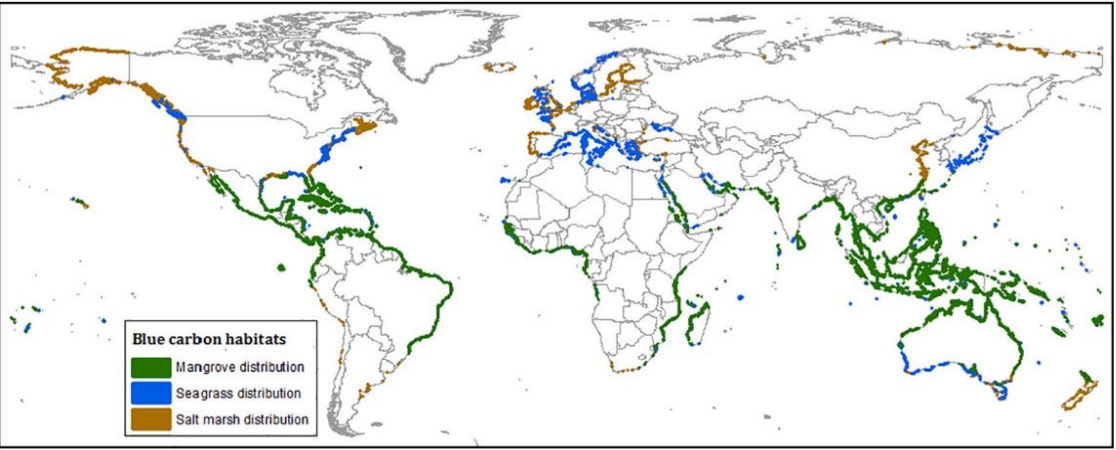
How did the origin of salt marsh and other plant-based foundation species habitats impact the ecological dynamics observed in those habitats?
Areas with a lot of primary succession plants were thought to be controlled by bottom-up forces (nutrients, tides, physical factors) with little effect of top-down (predation) forces.
Found later that plant competition and herbivory (crabs) had a large effect on zonation in these areas (top-down effects)
Main physical stressor in salt marshes
salinity stress
Saltwater evaporates=increase in salt levels=salty sad plants
What physical and biological environmental factors drive salt marsh community structures
Depends on area… but mainly
lower limits set by physical stress (waterlogged soil, anoxia) and upper limits set by competition (plant zones)
What is a foundation species
Species that create habitats and modify environments with positive effects on diversity, distribution and abundance of associated organisms
Name all foundation species in marine ecosystems
Reef-building corals, kelp, seagrasses, saltmarsh cordgrass, mangroves, oysters, hydrothermal vent tubeworms, sponges in Antarctica
What habitat/community were foundation species first described from
Sponges in Antarctica
How does the presence of a foundation species alter community structure/dynamics
can provide substrate as well as reduce biotic and abiotic stress and increase the food supply in area
results in higher diversity, abundance and biomass, wider distribution limits, and elevated rates of propagule retention, settlement and survivorship
Large and broad net positive effect on community structure
Describe the facilitation between Juncus grass species and Iva marsh elder species that illustrates a shift between competition and facilitation with environmental gradients in New England salt marshes
Juncus shades the soil surface and decreases salt build up
Low-marsh level plants aerate oxygen-poor soil and this benefits neighbor plants (Juncus aerates, Iva benefits. Iva pushes seaward) Juncus is weaker than Iva and is displaced closer to sea
What are seagrass habitats
highly productive ecosystems that are a nursery for many species, stabilize sediment, filter water, and recycle nutrients
What do seagrass habitats require to thrive
Where are seagrass habitats found?
Temperate and tropical seas+ freshwater communities
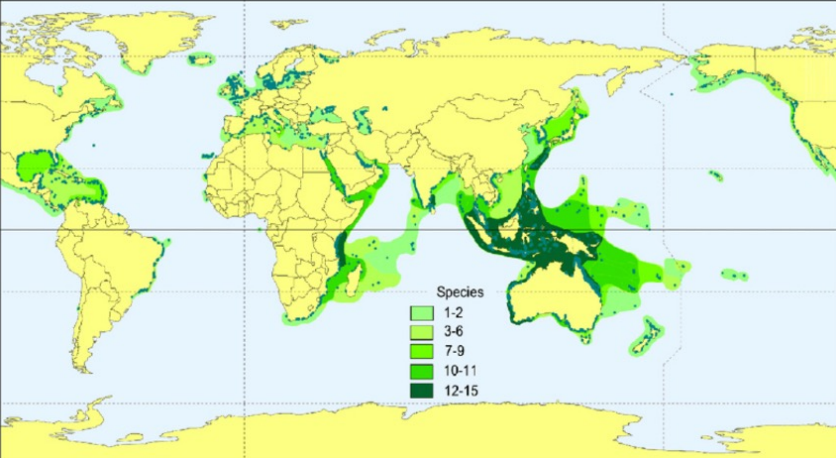
Describe how seagrass habitats have a positive effect on nearby coral reefs/mangrove habitats
seagrasses buffer coral reefs from terrigenous influence
binds sediment, absorbs nutrients, matures fish, filters bad bacteria
Coral reefs buffer waves/currents and export fish & nutrients
What were the main patterns/can you describe the figures in the study of the impact of run-off/untreated waste in islands across Indonesia where there are seagrass beds between the shoreline and the reefs versus areas where there are no seagrass beds?
decreases in amounts of bacteria in both the area between the shore and the reef and the reef in areas where seagrass is present.
What is the role of herbivory in seagrass habitats
Roles between big herbivores and small is unclear as well as the role of herbivores themselves
What is the mutualistic grazer model
A shift in the hypotheses for the major drivers of seagrass communities (thought to be bottom-up, but this model says perhaps top-down)
Grazers of algae and grazers of the seagrasses both increase the survivability of the seagrass ecosystem?? 4-level trophic facilitation vs 2 level
How does the mutualistic grazer model keep algae from dominating seagrass habitats
Dominance of seagrass as opposed to algae is influenced by grazing
Small crustaceans/gastropods reduce overgrowth of seagrasses by eating algae
Describe how a trophic cascade might work in seagrass habitats
Less top predator=more intermediate predator fish=crash in crustacean mesograzers= more algae= algae outcompetes seagrasses
Number of strong interactions is low so trophic cascade chances are higher
Describe two potentially stable states in seagrass communities and their factors
Feedback mechanisms reinforce states
Sea-grass dominated (high seagrass biomass= low efficiency of small predators, high abundance of mesograzers, low algal biomass)
Algae-dominated (low seagrass biomass, high small predator efficency, low abundance of mesograzers, high-algal biomass)
Facilitation
interactions between 2+ species where one species (at least) benefits and nobody is negatively affected
Can result from ecosystem engineering
Ecosystem engineers
modify physical habitat and provide whole-community facilitation
Foundation species
This “model” describes how seagrass beds provide shelter from predators for herbivorous species that then prevent microalgae from overgrowing and outcompeting the seagrass:
Mutualistic grazer model
How do dynamics of hydrothermal vents differ from other deep sea habitats? (enviromental parameters, gradients, types of species, nutreint levels, ecological drivers, habitat comp) ??????
Deep sea: Stable physical environment, mostly soft sediment, no light, low water temp, high pressure, constant salinity, slow currents, hella oxygen, low food
Primary producers of hydrothermal vents (via chemosynthetic microbial processes)
bacteria and archaea fix inorganic carbon into organic matter
free-living bacteria, endosymbionts, ectosymbionts
Environment of hydrothermal vents
rich in hydrogen sulfide, manganese, iron, methane, hydrogen, and toxic metals. Steep chemical and thermal gradients, high local biomass, no oxygen
How does most deep-sea biomass and diversity relate to latitudinal gradients, and what is driving this pattern?
Regions with higher primary production support more deep-sea benthos & high latitude regions have higher biomass
Driven by surface primary production
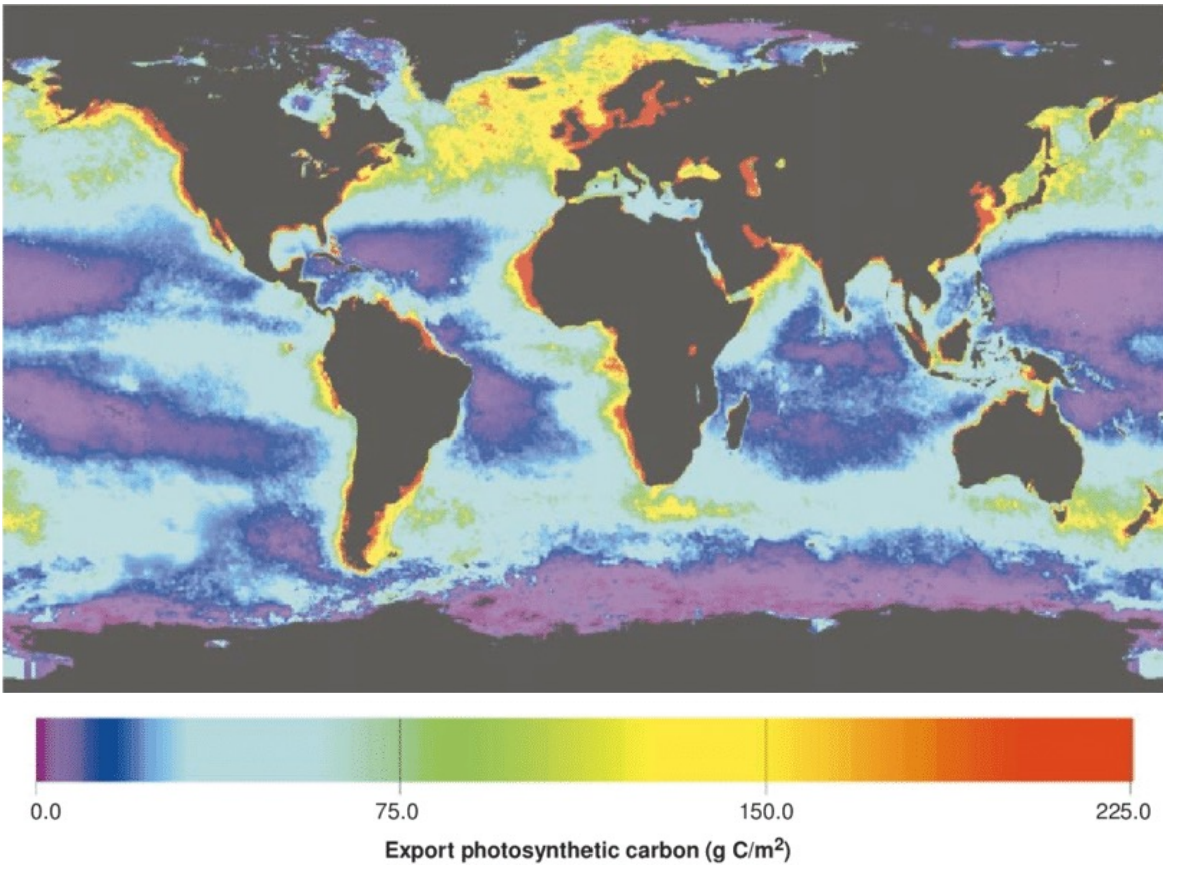
How/why do hydrothermal vent communities not follow latitudinal patterns for deep-sea biomass/diversity
They dont correlate with high surface productivity, they are associated with mid-ocean ridges
Distribution of hydrothermal vent communities
mid-ocean ridges, volcanic arcs and back arcs, hot spot volcanos all can form hydrothermal vents
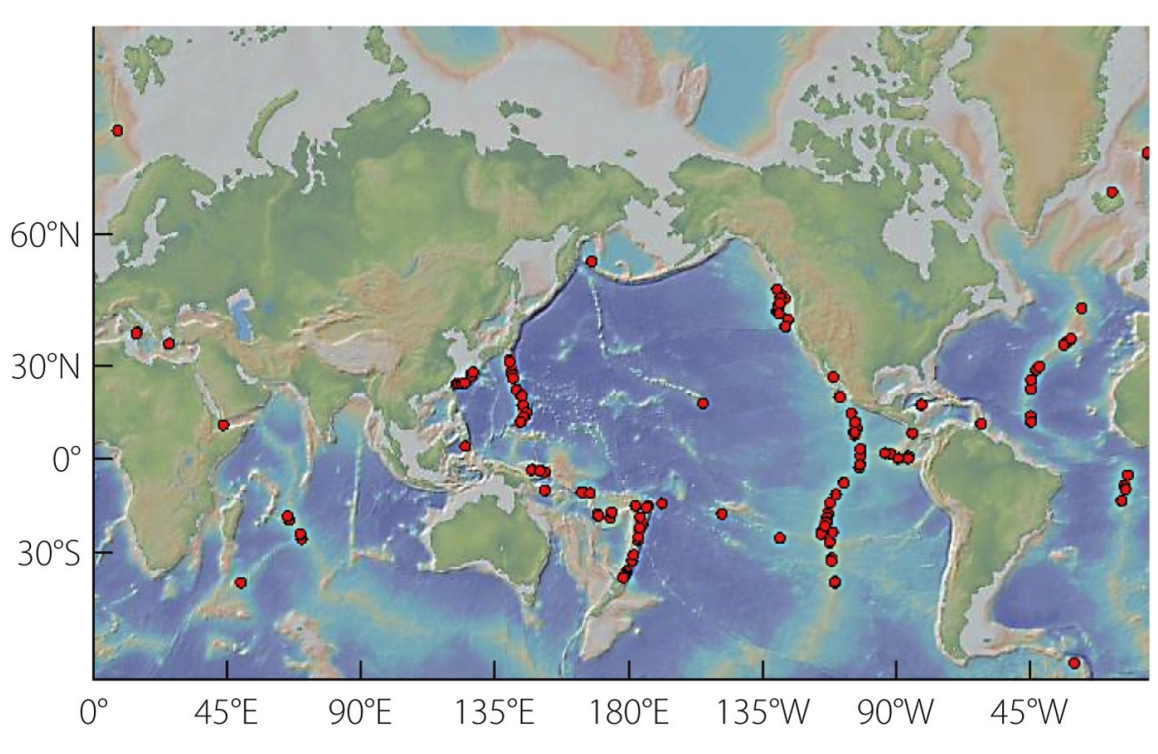
What information led scientists to hypothesize the existence of hydrothermal vents before getting “eyes” on them in the mid-1970s?
heat fluxes, high manganese concentrations, low magnesium concentrations
Why was the discovery of hydrothermal vents mindblowing at the time
Everyone believed that primary producers required light then they found primary producers that didnt need light
Different species form the “foundation species” around different hydrothermal vents – but what are the commonalities among these species in terms of their adaptations to these environments?
High temperature adaptation, novel photoreceptors (cant form images), fast-growing with high metabolisms
Siboglinid tubeworms, vesicomyid clams, bathymodiolid mussels, alvinocard shrimp, pompeii worm
What are the other species typically found around hydrothermal vents and what are the most common functional groups they fit into?
Mobile predators and scavengers: galatheid crab, brachyuran crabs, vent fish, vent octopus
Sessile suspension feeders: anthozoans, enteropneusts, serpulid polychaetes, barnacles
Are there large, mobile, top predators in hydrothermal vent communities
….kinda
There are vent fish and octopuses as well as crabs
What are the gradients in temperature, oxygen, toxic metals, hydrogen sulfide from the core vent plumes moving out?
Temp gets colder, oxygen gets higher, toxic metals gets lower, H2S gets lower
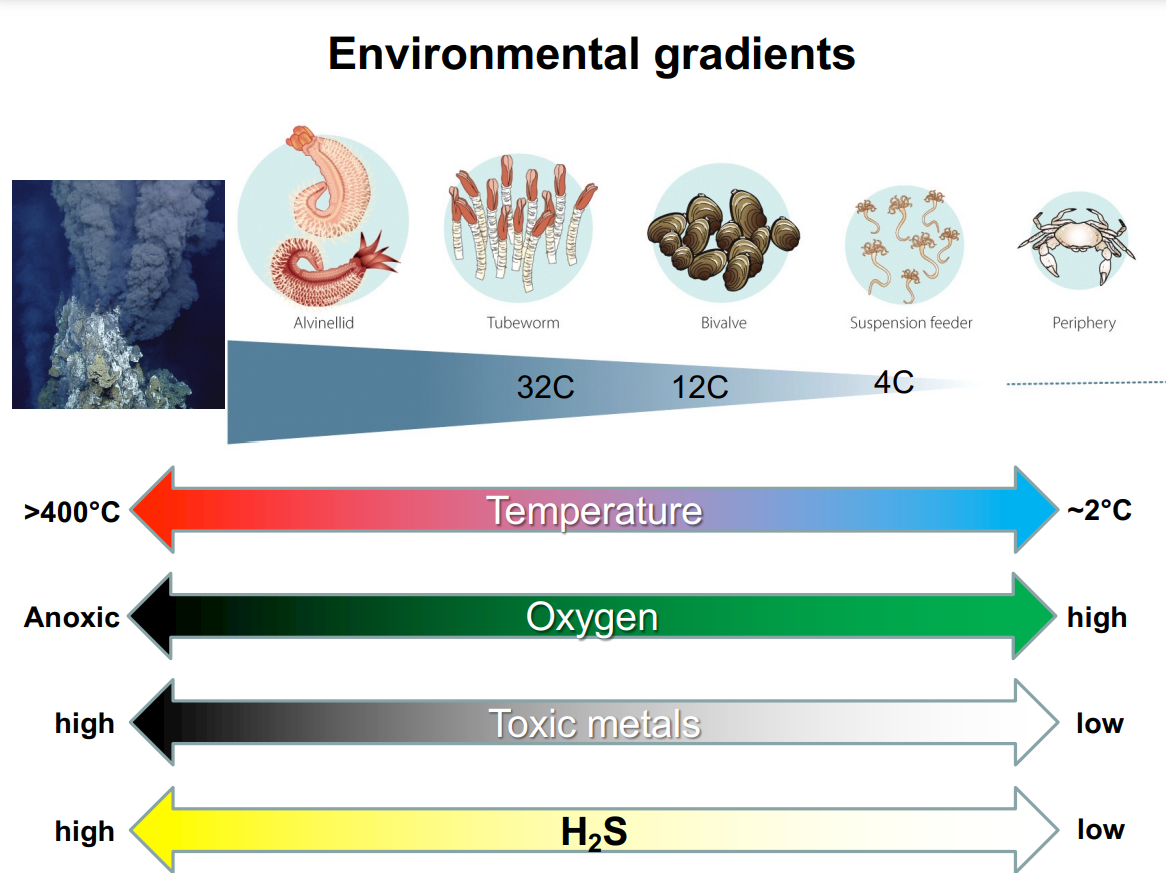
Given the distribution of vents in the deep sea, how does larval dispersal work in connecting these vent communities?
Rapid colonization and population growth suggest long-distance dispersal, migrate along mid-ocean ridges
Is there ocean basin-scale connectivity in deep-sea vents? Is each vent its own community of species?
vent fauna differs between oceans
How does the biomass of kelp forests change seasonally
Highest in winter (more nutrients, cold water)
Lowest in late summer/fall (low nutrients, warm water)
How do El Nino conditions affect kelp forests in California, and what is the specific cause and effect relationship(s)?
Higher abundance because upwellings=colder water=more nutrients
What are the major predators of sea urchins? How does this vary geographically
Codfish, wolf eel, crabs, sea otters, starfish, sheephead fish, lobsters
Why are sea otters considered keystone species in Alaska but considered to have less impact in California?
In California, sea urchins are also eaten by lobster and sheep head fish while in Alaska their main predator is sea otters.
Lower biomass of sea otters in California.
How do sea otters affect the biomass and depth distribution of kelp
they indirectly increase their biomass and allow more growth in the first 20m of water
Key limiting nutrient for kelp forests
nitrate
The majority of kelp forest productivity is…
exported to other habitats (kelp wrack) and eaten by deposit feeders
Photosymbiosis is a common strategy for organisms in the many tropical habitats but uncommon or absent in temperate and polar habitats. Explain the primary reason for this absence?
Colder waters have more nutrients present while warmer waters are nutrient-limited. Nutrients arent limited in the water, so nobody needs to create more yk
In general, how do coral growth rates change with depth and why?
no reef-building corals deep, but corals still grow
no light, so coral has to find other methods of energy accumulation. Harder/slower growth
How do growth morphologies of coral change with wave stress?
Higher wave energy=low-lying corals and algae less vulnerable to physical stress
Lower wave energy= upright and structurally complex corals
What are the main environmental factors driving growth forms in coral?
wave energy, seawater temperature, and primary production???
What is the (broad) latitudinal distribution of coral reefs?
For tropical, shallow-water, scleractinian coral
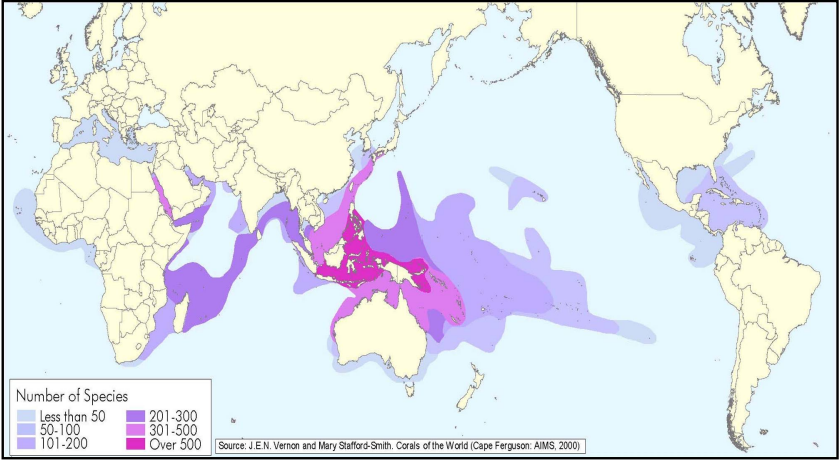
What environmental factors set the boundaries for reef habitat locations?
Limited at high latitudes due to low temperatures, not enough sun, Low aragonite levels, and competition with temperature fauna
Limited at depths due to lack of light, temperature, and bioerosion
Benefits between the symbiosis of Scleractinian corals and their endosymbiotic microalgae?
photosynthate materials (carbs, lipids, amino acids) excreted by algae
protection and nitrogenous waste provided by host
In addition to corals what other taxa engage in similar symbiotic relationships with microalgae?
octocorals, sea anemones, jellyfish, sponges, molluscs, foraminifera, flatworms
Is the symbiont community the same for all organisms or within a single species?
Not the same for all organisms. Some may have multiple types and others may have one type
Not necessarily all the same across a species, but can be.
What factors drive the level of similarity between two symbiont communities are?
Varies by species
biogeographic patterns
some clades are associated with higher tolerances to stress
?????
There is a center of high biodiversity of shallow water marine organisms centered around Indonesia, Malaysia, the Philippines, and Papua New Guinea, and a gradient of reduced biodiversity away from this center. What is one of the main hypotheses for this gradient and the logic behind it?
The large amount of shallow-water habitat in this area
Supported by the
How do wave energy, SST, and levels of primary production shape how a reef community is likely to appear?
higher wave energy=low-laying coral and increased grazing
higher SST= support more coral and increased detrivores
Higher PP= more microbes, high coverage of calcifying benthic organisms, increased food consumption for fish and increased fish biomass
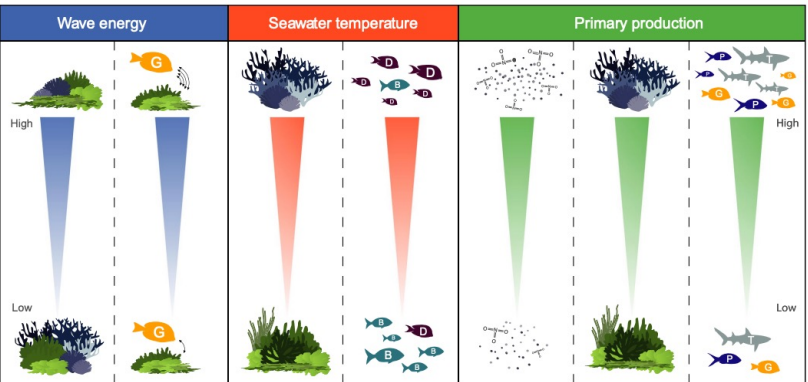
Explain the shift from coral-dominated to algal-dominated communities.
coral gives increased structure, more grazing, increased fish recruitment, reduced macroalgae, more coral = positive feedback loop
reduced coral, reduced structure, too little grazing, reduced fish recruitment, reduced grazing, increased macroalgae, decreased coral recruitment= negative feedback loop
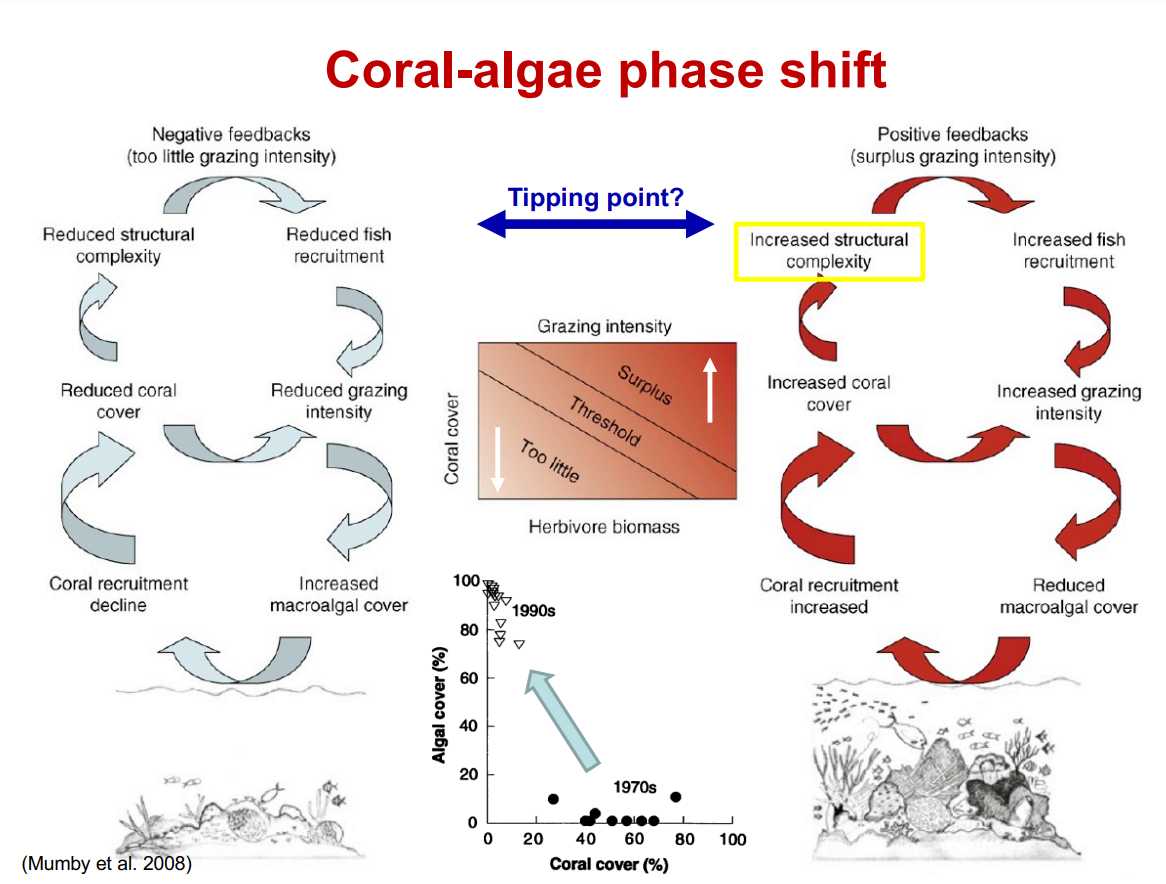
What are the 2 leading hypotheses of the cause of crown-of-thorn (COT) outbreaks?
Primary outbreaks: Suddenly all pop up after a period of rarity. Due to change in environmental condition
Secondary: Hella larvae from the primary outbreak= a second generation
In terms of coral community structure, what have been the impacts of coral bleaching events on the Great Barrier Reef?
physiologically and nutritionally compromised coral
Corals that survive a bleaching event have thicker tissues and higher mass transfer
????
Fringing reef
borders shoreline directly
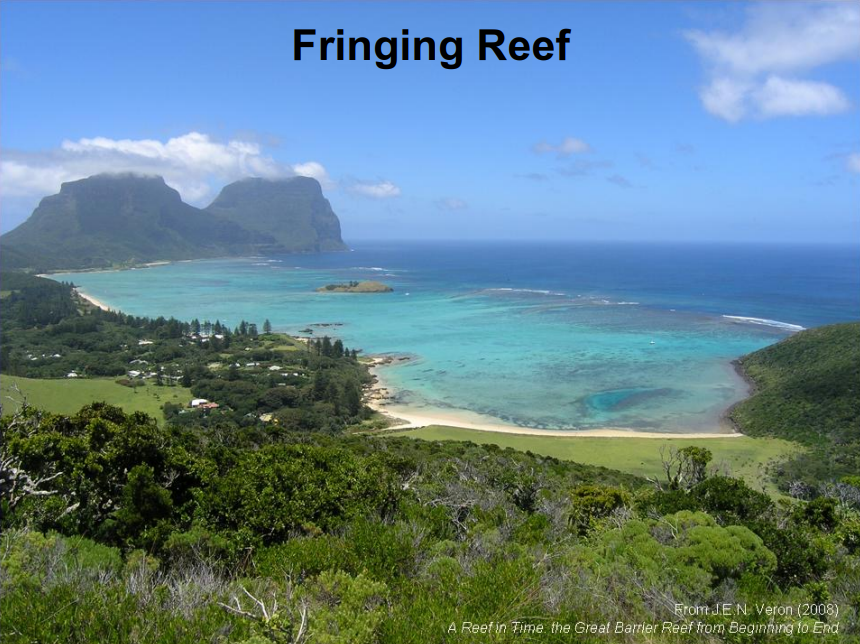
Barrier reef
border shoreline with a lagoon between shore and reef
Made of three zones: back reef, reef crest, fore reef (going outwards)

Atoll
reef forms around volcanic island and continues after volcano sinks below sealevel
island erosion, island sinking, reef accretion
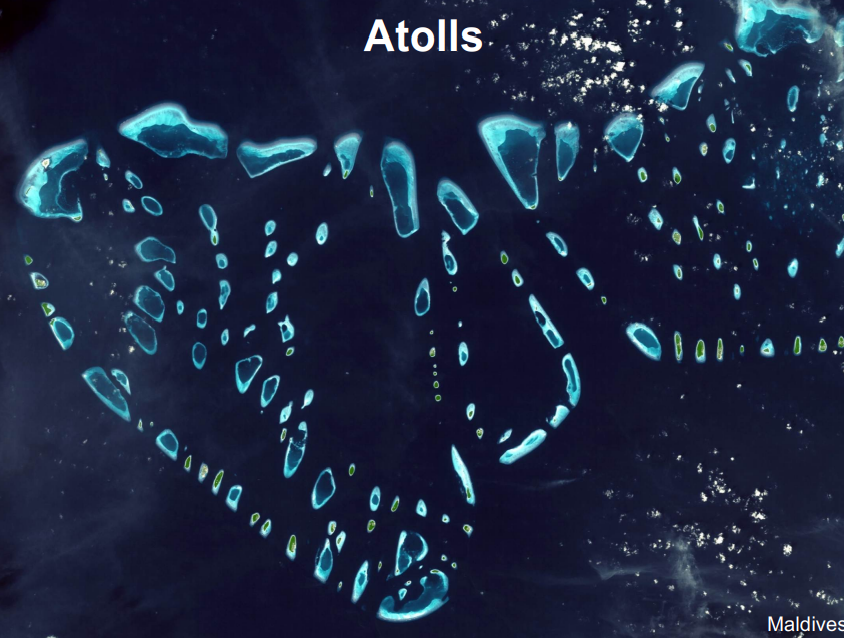
Free living coral
single polyps
branching coral
usually fastest growing
plate-like coral
often found in deep water
Massive/lobed coral
usually slower growing and k-selected
Encrusting coral
tolerates higher physical disturbance but sometimes parasitic
Foliaceous coral
delicate; usually found in deep water
Potential causes for coral bleaching
thermal stress, too much sun, low salinity, hypoxia, too much sediment, prolonged subaerial exposure, bacterial infections, chemical pollutants
What were the main factors causing thiscoral-algae phase shift in the Caribbean, particularly Discovery Bay, Jamaica?
overfishing, hurricanes, eutrophication, disease
Overfishing of herbivorous fish, coastal eutrophication, hurricanes, sea urchin die-off due to bacteria, White-Band disease (coral)
Alternate stable states: Phase shifts
A positive feedback loop keeps the habitat solid, but after too many negative occurrences tipping point occurs and the negative feedback loop starts
Difficult to move between loops and hard to predict when the tipping point will occur that switches the loops
Kelp forest and urchin barren alternate stable states
